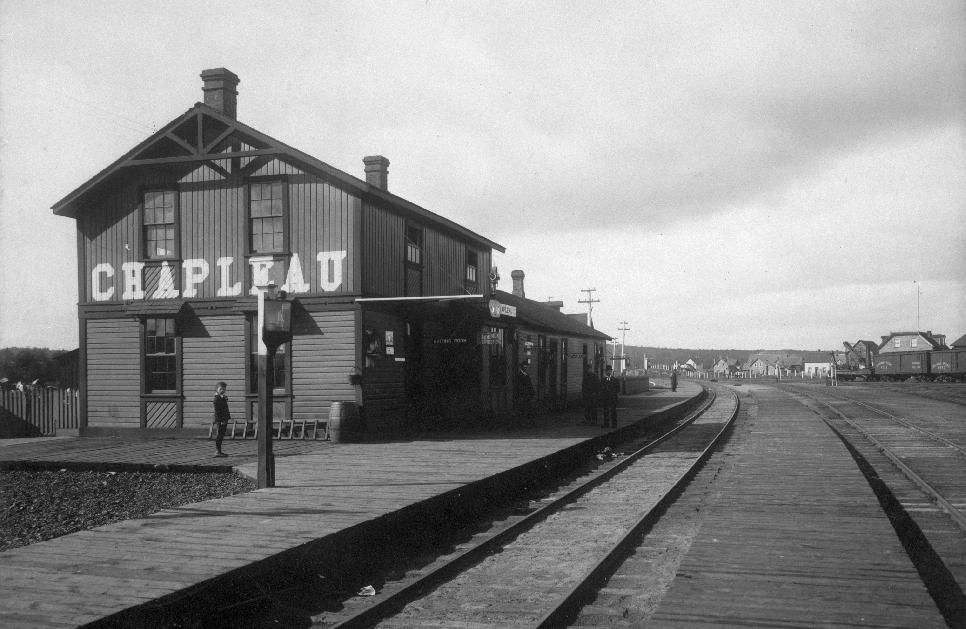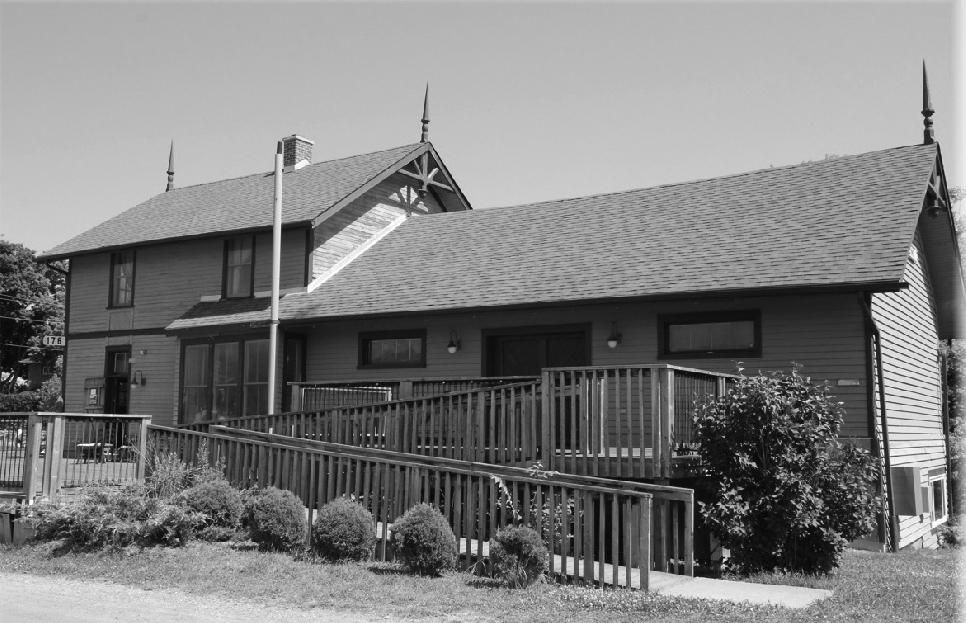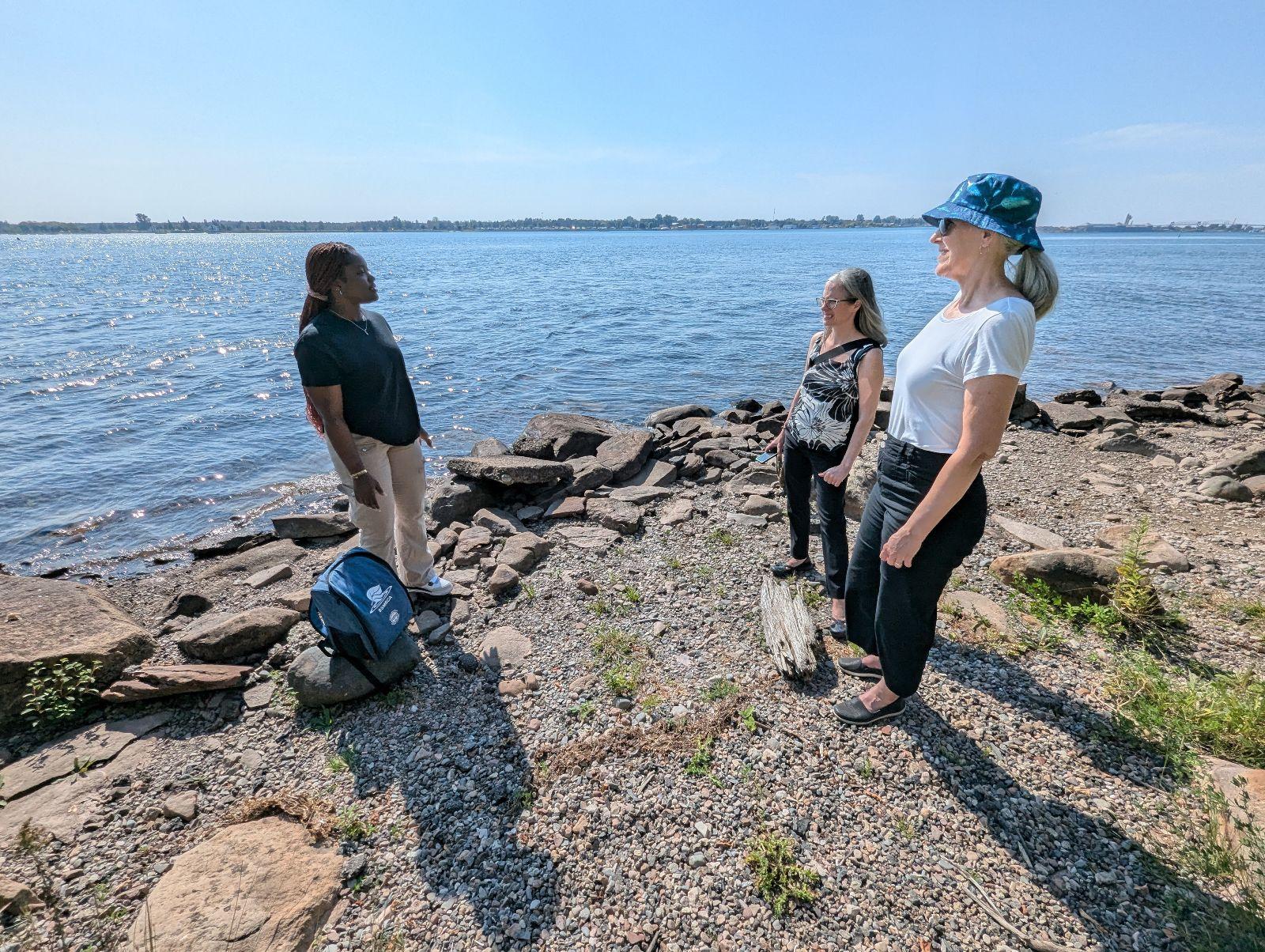




Last week, students and staff at École
Sacré-Coeur (Chapleau) proudly paid tribute to Terry Fox during an annual walk in his honour. Participants dedicated their run to a loved one or a person of their choice.
Like Terry, the school community set itself a goal: to raise $2,000 for the Terry Fox Foundation ÉcoleSacré-Cœurfamiliesshowed incredible generosity and surpassed their goal, raising no less than $3,205 for the cause. This







Lesélèvesetmembresdupersonneldel'écoleSacré-
Coeur (Chapleau) ont fièrement rendu hommage à Terry Fox la semaine dernière lors d'une marche annuelle en son honneur. Les participants ont dédié leur course à un être cher ou une personne de leur choix. Comme Terry, la communauté scolaire s'était fixé un objectif:recueillir2000$pourlaFondationTerryFox.Les

successisareflectionofCatholicvaluesandthe spirit of solidarity that reigns in the Chapleau community Congratulations to École SacréCœur school on the success of this annual initiative!

familles de l'école Sacré-Cœur ont fait preuve d'une générosité incroyable et ont surpassé leur objectif en amassantpasmoinsde3205$pourlacause.Cetteréussite est le reflet des valeurs catholiques et de l'esprit de solidarité qui règne dans la communauté de Chapleau. Félicitations à l'école Sacré-Cœur pour le succès de cette initiativeannuelle!
Temperatures
Septemberwaswarmerthannormal;the mean temperature anomaly was above normal across the entire province.Values were greatest intheFarNorthanddecreasedsouthwardbeing lowest in southwestern Ontario. The higher values are considerably greater than for recent months. In fact, toward Manitoba in the Far Norththemeantemperatureanomalywas+5oC.
Daily temperatures were variable provincewide during the first two weeks. Most locations saw their coolest days this month around the end of the first week. Parts of the northeastsawsomedailyhighsonlyinthesingle digits(suchasTimminswithonly7.6oC)onthe 7th.After this cool snap, temperatures climbed, and a prolonged warmer-than-normal period beganlastingwellintothe4thweek.Thiswasthe longestwarmspellinmanymonths.Itwasmore intenseinthenorthandFarNorthwhererecord highsweresetincludingatMoosoneeonthe14th (30.1oC) and atAtikokan on the 18th (30.0oC). Slightlycoolerairmovedintoendthemonthfor most regions, but temperatures were still above normal.
Precipitation
Afteraverywetsummerinthesouth,the provincesawadrierthannormalmonthformost oftheprovince.Precipitationwasnearorslightly above normal, however, around southern James Bay south to near North Bay, in the GTA, and near the Manitoba border Toronto Pearson saw 130%ofthemonthlynormalcontinuingthetrend fromallsummermonthsandindeedthespring.
Two major precipitation events swept across the province, from the Far North to the

southeast, on the 4th-8th and 21st-23rd with the second generally producing the most precipitationforthemonth.Partsofnorthwestern Ontario also had significant precipitation on 15th-19th.Manylocationssawanextendedmidmonth period without any measurable precipitation and at some locations this lasted over2weeks.Someofthehighestdailyamounts recordedinclude57mmatMarathon(Pukaskwa) onthe5thand47.8mmatTorontoPearsononthe
23rd.
OutlookforOctober
The outlooks suggest warmer than normal conditions next month with good agreement between the Canadian and European models Both suggest the highest likelihood toward the Far North Similarly, there is agreement for a drier than normal month especiallyinthesouth.
New funding will ensure continued delivery of in-demand resources and services to First Nations communities
TheOntariogovernmentisinvestingan additional $1 25 million annually in First Nations public libraries to ensure continued delivery of in-demand resources, services and programmingtothecommunitiestheyserve.
“First Nations public libraries are vital community hubs that provide residents of all ageswithaccesstosupportspromotingsuccess in school, enable skills development and reinforce and revitalize cultural identity,” said Stan Cho, Minister of Tourism, Culture and Gaming.“Thisinvestment,thefirstofitskind in more than 25 years, underscores our government's continued efforts to ensure communities across Ontario have the critical
infrastructure in place to empower their residentstolearn,growandthrive.”
Thisenhancedfundingwillbeprovided toeligibleFirstNationspubliclibrariesacross the province through two existing library support programs: the First Nation Salary Supplement (FNSS) and Public Library OperatingGrant(PLOG).
AnnualFNSSallocationswillincrease from $13,000 to up to $35,000 per eligible library to support the retention and hiring of librarians and support staff. Additionally, current PLOG allocations for First Nations public libraries will double, with a minimum annual grant of $1,500 per eligible library
providedtohelpensurestableoperations.
“Today's announcement of an additional $1.25 million annually for First Nations public libraries is part of our government's commitment to ensuring that reconciliationbecomesarealityforIndigenous familiesandcommunitymembers,”saidGreg Rickford, Minister of Indigenous Affairs and First Nations Economic Reconciliation and Minister of Northern Development. “We understand that libraries are woven into the fabricofFirstNationscommunities,servingas a key resource for education, skills development, as well as cultural development forallgenerations.”

by MichaelJ. Morris
Here is part two of Ian Macdonald's thoughts on Chapleau's heritage buildings I appreciatesomuchthetimeandhoursofresearch Iandidtowritethesetwoarticles.Inthebeginning, IthoughtImightjustaskhimafewquestions. Ian has a sincere interest in the community , like so manyofuswhoareChapleau"boysandgirls"but no longer live there. Ian is retired head of the department of architecture at the University of Manitoba and Professor Emeritus. Thanks Ian.... MJM
Buildings are an important part of

Chapleau’sculturalheritageincludingtheoriginal CPRdepotopenedin1886thatwasdescribedina previous article and presently located on Monk Street. In most instances, historically important buildingslikethiscanbegivenasecondorthirdlife through adaptive-use or adaptive re-use.Adaptive re-use is an approach where the original major elements(windowtypes,doortypes,finishesetc.) of the original building are maintained but modifications are made to accommodate a completelydifferentoccupancythantheoriginal.
One example of imaginative adaptive reuseistheRotaryClubfacilityinStirlingOntario( population2139).Thisbuildingwasoriginallyone ofthefirstT-1typerailwaydepotsinCanadavery similartothefirst CPRdepotbuiltinChapleau.A newfoundationwasbuiltfortheoldStirlingGrand Trunk depot on a more central site in the communityandthebuildingwasliterallypickedup and relocated there. A barrier free ramp was constructed to meet present day building code requirements. The restored Stirling facility includes a tourist information centre and an antiques and
IanMacdonaldargues'thinkingoutofthebox'required tosaveChapleau'sremainingheritagebuildings.
collectibles shop. Downstairs is the Rotary Hall, wheretheStirlingRotaryClubmeetseveryweek. The hall is rented out for parties, business events and meetings. This was part of the business plan that was developed to make the facility economicallysustainable.
Anotherexampleofadaptivere-usecloser to home was carried out by an ambitious group in the small town of Dubreuilville, Ontario (population635).TheformerCPR/ACRdepotat Franz was acquired and moved approximately twelve miles from Franz to Dubreuilville where it was placed on a new foundation, restored and is now a fully functional tourist information/ souvenirshop.
The Hudson’s Bay Company played an important role in the early days of Chapleau. The Chapleau post was, for a brief time, the headquarters of the Michipicoten district of the HBC However, the first building constructed by the HBC was in 1884 as CPR construction was approaching whatisnowChapleau. Itwasasmall log sub-post (post with two outbuildings) on the

Nebskwashi River approximately a mile south of the community on what is now IR 61 of the ChapleauOjibweFirstNation.
The next buildings, which were built in 1886,werearetailstoreonthesouthwestcornerof Birch and Young Streets (site of the old Algoma Hotel)andaresidencefortheirpostmanageratthe west end of Pine Street.The log sub post south of town was abandoned in 1889 and the retail store apparentlyburnedin1895.Theresidencewassold bytheHBCshortlythereafterandstillexiststothe presentday.
The style of the HBC house isn’t particularlyuniqueandissimilartothemajorityof the first homes built in Chapleau in the late nineteenth century It is, however, significant because of its relationship to the Hudson’s Bay Companyeraandwasoneofthefirsthousesbuilt in Chapleau in the late nineteenth century It is, however, significant because of its relationship to theHudson’sBayCompanyeraandwasoneofthe first houses built in Chapleau in the early days of


1885and1886.Thelocationofthishouseadjacent tooneofChapleau’smainintersectionsobviously provides the potential for restoration as a tourist informationcentreorothersimilarfunction.
Many Important Chapleau buildings have been demolished but those remaining include St.John’sAnglicanChurchcompletedin1908,the Legion Hall opened in 1920 and the Post Office building completed in 1950. Each of these buildingshashistoricalsignificance.
There is no established formula as to how tobreathelifeintoanolderbuildingbutonehasto accept that the task is never easy Church restorations in particular are complicated St.John’sChurch,forinstance,obviouslyhastobe saved despite not having a large enough congregationtosupportit.Inthiscase,sentimental associationwithformertimesandtraditionshasto be abandoned to ensure that a wide range of developmentpossibilitiesisrevealedregardlessof the discomfort that this might first create.Agood measure of thinking “outside the box” will be required to sustain the social usefulness of this building for future generations. The good news is thatmanychurchesinCanadahavehadtodealwith thesamechallengeanddevelopedawidevarietyof innovative,practicalandsuccessfulsolutions.
One can only hope that the people on Council,CDECandotherpositionsofinfluencein the community recognize that older buildings can offeropportunitiesaforacommunity’sfuture. MJMemailismj.morris@live.ca

by/par Carol Hughes Federal member of Parliament Algoma-Manitoulin-Kapuskasing
In late September, Jennifer Morgan, the German state secretary and special envoy for international climate action made a relatively innocuous comment that seemed to prod a wide range of responses from businesses and political leadersacrossCanada.Asanenvironmentalistand former executive director of Greenpeace, she said "allstudiesshowthatthemarketisgoingtoshrink," referring to the reliance Germany and other European countries have on Canadian natural gas imports. "Germany will be driving forward on renewables,andgasdemandwilldecline."
Thisisnotacommentthatexistsoutsideof the realm of reality It's actually quite reasonable when we think about the lead many nations are takingonreducingtheirdependenceonfossilfuels and becoming energy independent, particularly in Europe as many nations divert importing LNG from Russia following their illegal invasion of Ukraine. Europe has been actively reducing their imports following the invasion, moving from importing around 40 percent of their LNG from Russia in 2021 to approximately eight percent in 2023. A significant drop, to be sure, but it also followsatrendofEuropeansusinglessnaturalgas than they have in the past. They have still been importing LNG, but the dominant countries in which they are importing have been Norway, the U.S., North Africa, and Qatar, with Canada not reallybeingafactor.
The Germans have been taking a much harder track towards reducing their carbon emissions than we have. They are seeking to become net-zero emitters by 2045, five years ahead of currentCanadiantargets.GermanyisbothEurope's largest economy, and currently its largest carbon emitter By the country's current projections, Germany seeks to reduce its gas imports by 30 percent by 2030 and a whopping 96 percent by 2050. Those aren't targets, but their predictions, accordingtoMorgan.
But her commentary on this matter isn't simply speculation. A recent report from the International Institute for Sustainable Development (IISD) states that Canadian LNG isn't the answer for Europe's short-term energy needs. With no liquefied natural gas export infrastructureavailableuntilatleast2025andaccelerating climate commitments from member states, it seemsasifthetimelinetoexportLNGtoEuropeis rapidly shrinking. That's not to say that there wouldn'tbeamarketforCanadianLNGelsewhere in the world According to Natural Resources Canada, there are eight LNG export projects in various stages of development across Canada. It's
justthatEuropeisusingfarlessLNG.Accordingto the U S Energy Information Administration, natural gas consumption declined 18% from the previous five-year (2017–21) average across the EU.
It's evident that Germany and other EU countries remain interested in our other natural resources.Thissummer,bothCanadaandGermany committedtoa$600millionpacttoexporthydrogen.Thereisaneedforcriticalmineralsacrossthe worldthatCanadaishappytoexport,tothetuneof $153.1 billion in 2022 and accounting for 21% of all Canadian merchandise exports, including iron, steel, gold, nickel, potash, and other critical commodities.
However,it'sMorgan'scommentsonLNG specifically that seem to have riled up people uninterested in addressing climate change. The Deputy Leader of the Conservatives, following
Morgan's interview, stated “while the CBC interviewsclimateactivistsassociatedwithGreenpeace fromforeigncountriestomakethecaseforkilling Canadianpaycheques,thefactisthatEuropecame knocking begging for our world class LNG..." Perhaps insulting foreign leaders is not the best approach to selling LNG in foreign markets. It's somewhat understandable that Conservatives would get up in arms about Morgan's comments. The party's national council has a number of oil lobbyists helping form their opinion on these matters. But that doesn't change whether foreign marketsarelookingtobuyourLNG
Foreign markets are looking to buy our resources,andthat'sagoodthing.Butwecan'tsell themwhattheyaren'twillingtobuy.Giventhestate oftheclimatecrisisweareexperiencing,weshould befollowingtheleadofcountrieslikeGermanyin prioritizingareductioninouruseoffossilfuels.
Commentairesdel'envoyéeallemandesurlegaznaturel: unsignequedesdiscussionssurl'énergiesontàvenir?
À la fin septembre, Jennifer Morgan, secrétaire d'État allemande et envoyée spéciale pour l'action climatique internationale, a fait un commentaire relativement anodin qui a semblé susciterunlargeéventailderéactionsdelapartde dirigeants d'entreprises et politiques de tout le Canada En tant qu'écologiste et ancienne directricegénéraledeGreenpeace,elleadéclaré que«touteslesétudesmontrentquelemarchéva serétrécir»,faisantréférenceàladépendancede l'Allemagne et d'autres pays européens à l'égard des importations de gaz naturel canadien « L'Allemagne va miser sur les énergies renouvelablesetlademandeengazvadiminuer ».
Cecommentaireesttoutàfaitconformeà laréalité.C'estenfaitassezraisonnablequandon mesurel'avancequeprennentdenombreuxpays pour réduire leur dépendance aux combustibles fossiles et devenir indépendants sur le plan énergétique, en particulier en Europe où de nombreuses nations se détournent des importations de GNL en provenance de Russie depuis son invasion illégale de l'Ukraine L'Europe a activement réduit ses importations à la suite de l'invasion, qui sont passées d'environ 40 % de GNL importé de Russie en 2021 à environ8%en2023.Ils'agitcertesd'unebaisse importante, mais elle s'inscrit également dans la tendance des Européens à utiliser moins de gaz naturelqueparlepassé.Ilscontinuentd'importer duGNL,maislesprincipauxpaysd'importation sont la Norvège, les États-Unis, l'Afrique du NordetleQatar,leCanadan'entrantpasvraiment enlignedecompte.
LesAllemandssesontengagésdansune
voie beaucoup plus stricte que la nôtre pour réduireleursémissionsdecarbone.Ilscherchent àdevenirdesémetteursnetszérod'ici2045,soit cinq ans avant les objectifs actuels du Canada. L'Allemagneestàlafoislaplusgrandeéconomie d'Europeetsonplusgrandémetteurdecarbone. Selon les projections actuelles du pays, l'Allemagne cherche à réduire ses importations degazde30%d'ici2030etdepasmoinsde96% d'ici 2050. Il ne s'agit pas d'objectifs, mais de prévisions,selonMmeMorgan. Mais son commentaire sur ce sujet ne relève pas de la simple spéculation. Un récent rapport de l'Institut international du développement durable (IIDD) indique que le GNL canadien n'est pas la réponse aux besoins énergétiques à court terme de l'Europe. Comme aucune infrastructure d'exportation de gaz naturelliquéfiéneseradisponibleavantaumoins 2025 et que les États membres prennent de plus en plus d'engagements en matière de climat, il semble que le délai pour exporter du GNL vers l'Europes'amenuiserapidement.Celaneveutpas dire qu'il n'y aurait pas de marché pour le GNL canadien ailleurs dans le monde. Selon Ressources naturelles Canada, il existe huit projetsd'exportationde GNLàdifférentsstades de développement au Canada. C'est simplement que l'Europe utilise beaucoup moins de GNL Selon l'Energy Information Administration des États-Unis, la consommation de gaz naturel a diminué de 18 % par rapport à la moyenne des cinq années précédentes (2017-2021) dans l'ensembledel'UE
Ilestévidentquel'Allemagneetd'autres SuiteP.7






On Oct. 18, 1977, New York Yankees outfielder ReggieJacksonhitthreehomerunsinarowoffof three consecutive pitches from three different pitchers -- a feat only Babe Ruth had ever previously pulled off -- in the sixth game of the WorldSeriesagainsttheLosAngelesDodgers. Lastweekssolutions
SuitedelaP.4
paysdel'UErestentintéressésparnosautres ressources naturelles. Cet été, le Canada et l'Allemagnesesontengagésdansunpactede 600 millions de dollars pour exporter de l'hydrogène Le monde entier a besoin de minérauxcritiquesqueleCanadaestheureux d'exporter, à hauteur de 153,1 milliards de dollars en 2022, ce qui représente 21 % de toutes les exportations canadiennes de marchandises,ycomprislefer,l'acier,l'or,le nickel,lapotasseetd'autresproduitsdebase essentiels
Toutefois,cesontlescommentairesde

Take advantage of our BOOST in online traffic!
Since the beginning of the coronavirus pandemic, people have increasingly turned to their local newspapers for reliable information. In just a few weeks, the number of readers of our digital version of the newspaper has increased by 55%. WEARE REACHING MORE PEOPLE THAN EVER BEFORE!
If you want to benefit from this surge in web traffic, NOW’S THE TIME TO ADVERTISE. CHAPLEAUEXPRESS

Email us with your needs at chaexpress@sympatico.ca or call us at 705-864-2579 THANK YOU FOR YOUR CONTINUED SUPPORT!
Mme Morgan sur le GNL en particulier qui semblent avoir offusqué les personnes peu intéressées par la lutte contre les changements climatiques. La cheffe adjointe des conservateurs a déclaré ceci après l'entrevue de Mme Morgan : «Alors que la CBC interviewe des activistes climatiques associés à Greenpeace dans des pays étrangers pour justifier la destruction des chèques de paie canadiens, le fait est que l'Europe est venue frapperàlaportepourobtenirnotre GNLde classe mondiale... ». Insulter les dirigeants étrangers n'est peut-être pas la meilleure approche pour vendre du GNL sur les marchés étrangers. Il est assez compréhensible que les conservateurs s'insurgent contre les commentaires de Mme Morgan Le conseil nationalduparticompteuncertainnombrede lobbyistes pétroliers qui l'aident à se forger une opinion sur ces questions. Mais cela ne changerienaufaitquelesmarchésétrangers cherchentàacheterounonnotreGNL. Les marchés étrangers cherchent à acheter nos ressources, et c'est une bonne chose.Maisnousnepouvonspasleurvendre ce qu'ils ne sont pas prêts à acheter. Compte tenu de l'état de la crise climatique que nous connaissons, nous devrions suivre l'exemple de pays comme l'Allemagne en donnant la prioritéàlaréductiondenotreutilisationdes combustiblesfossiles

to Friday
INEXPENSIVEPRICES GIVE USACALLAT 1-705-264-4334
to Friday: 1 lb. to 10,000 lbs 1-705-363-7804
ALCOHOLICS ANONYMOUS (A.A).Open discussion meeting every Monday evening. Brunswick House First Nation Band office lounge 7pm.NarcoticsAnonymous(N.A)everyTuesdaysameplacesametime. NNADAPWorker@864-0174info.
CHADWIC HOME, FAMILY RESOURCE CENTRE. Offers shelter, emotionalsupport,andinformationforwomenandtheirchildrenwhoarein crisissituations WehaveaTollFreeCrisisLinewhichisstaffed24hoursa day WecanarrangeforfreetransportationtotheCentreforwomenwho liveintheAlgoma/Chapleauarea Wealsooffersupporttowomenwholive in the communities of Chapleau, White River, Dubreuilville, and HornepaynethroughourOutreachProgram OurOutreachWorkertravels tothosecommunitiestomeetwithwomenwhoneedemotionalsupportas wellasinformationabouttheirrightsandoptions Ifyouneedtospeakwith the Outreach Worker when she is in your community, you can call the Centre at any time to set up an appointment You do not need to be a residentoftheCentreinordertouseourservices Ifyouneedsomeoneto talktoorifyoujustneedsomeonetolisten,callourTollFreeCrisislineat1800-461-2242oryoucandropinattheCentre Wearehereforyou




NORDIK Instituteisproudtoannounce thatitisoneofsevenrecipientsacrosstheGreat Lakesbasintoreceivecommunity-basedscience funding under the Great Lakes Freshwater Ecosystem Initiative. The project, CommunitybasedMonitoringintheNorthernGreatLakes,is led by Dr. Elaine Ho-Tassone, Director of Operations at NORDIK Institute and Adjunct Faculty in the School of Life Sciences and the Environment atAlgoma University. The initiative,whichwillrununtilMarch2026,willfocus on assessing water quality across Northern Ontario, and has received $120,000 from EnvironmentandClimateChangeCanada.
Tomarkthestartoftheproject,stafffrom Environment and Climate Change Canada visited NORDIK Institute on September 17 to meetwithcollaboratorsandlearnmoreaboutthe region's unique water challenges. The project

will engage communities in participatory science, allowing local residents to contribute directlytowaterqualitymonitoringinthelower Lake Superior and northern Lake Huron watersheds.TheTownshipofHuronShores,Township ofThessalon,MissanabieCreeFirstNation,and the Sault Ste. Marie Water Rangers Team are among the groups and communities currently involved, with the invitation extended to other communitiesandNationstoparticipate.
Dr. Ho-Tassone and the water team at NORDIK-KikiVetrieandAjazShaikh-aimto develop a practical, community-based approach towatermonitoringinthenorthernGreatLakes. Bycollaboratingwithlocalresidentsandidentifying each community's water-related priorities, the project seeks to create actionable, community-driven plans. These priorities will be communicated to key stakeholders such as Environment and Climate Change Canada, the International Joint Commission, and other relevant authorities to ensure local needs are reflected in regional and basin-wide water managementdecisions.
Building on past successes, including partnerships with two local First Nations under Ontario's Great Lakes Local Action Fund, NORDIK also launched the Sault Ste. Marie Water Rangers (WatR) Team earlier this year. Supported by the Sault Ste Marie Region ConservationAuthorityandtheCityofSaultSte.
Marie, the team has engaged over 1,000 local communitymembers,collectingmorethan3,000 publicly available data records on surface and groundwater quality, pollution, wildlife behaviour,andenvironmentalDNA
In addition to serving community needs, NORDIK'swaterteamisengagingwithdecision makerstocreatedirectpathwaysforcommunity data to be utilized. Earlier this year, NORDIK Institute became the first non-governmental partner of the Provincial Water Quality Monitoring Network, which has been the main network of surface water quality partners in Ontario for 60 years. NORDIK also recently joined the Provincial Groundwater Monitoring Network, through which the water team also contributestoHealthCanada'sPestManagement Regulatory Agency's data needs Further, NORDIK's water staff are engaging with the International Joint Commission's Water Quality and Science Advisory Boards and the Canada WaterAgency'sNationalDataStrategyprocess. GetInvolved
Communities interested in collaborating in the project, individuals looking to join the SSMWaterRangersTeam,orformoredetailson this important initiative, contact NORDIK Inst
n (info@nordikinstitute.com).
NORDIK (Northern Ontario Research, Development,IdeasandKnowledge)Instituteis an innovative community-based research institute affiliated withAlgoma University It is committedtothepracticeofholisticcommunity development and has established strong links with other research institutes, universities, and colleges. NORDIK is committed to building local research capacity by working closely with its community partners and providing mentorship to new researchers and community development practitioners. For more information,pleasevisitwww.nordikinstitute.com.